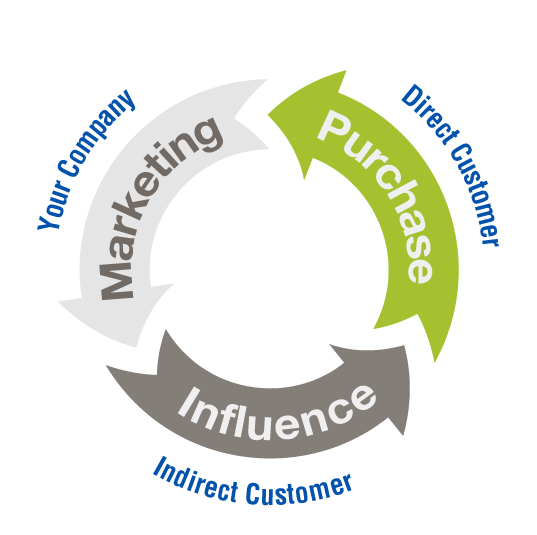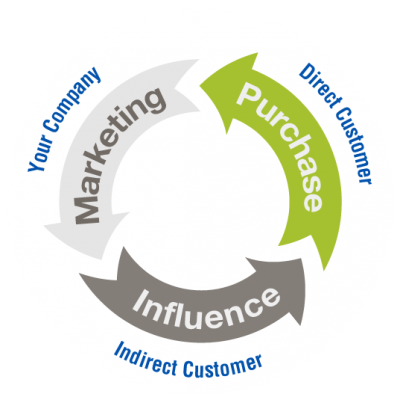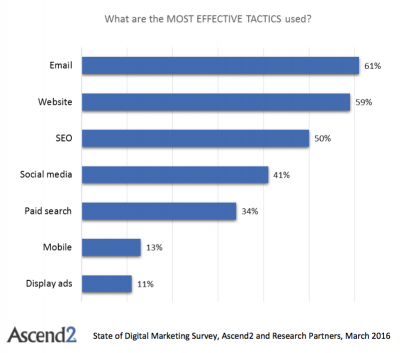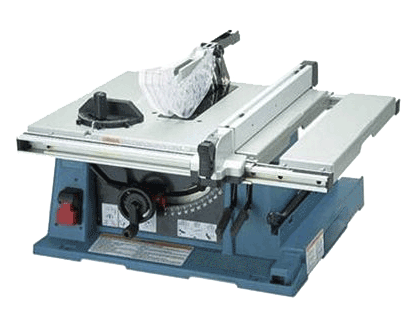 From your potential buyer’s point-of-view, your company’s website is like your salesperson, and it’s very likely the first “salesperson” he or she will encounter. That’s because buyers prefer to do online research first, rather than contact a company directly, to get the information they’re looking for.
From your potential buyer’s point-of-view, your company’s website is like your salesperson, and it’s very likely the first “salesperson” he or she will encounter. That’s because buyers prefer to do online research first, rather than contact a company directly, to get the information they’re looking for.
In fact, 94% of today’s B2B buyers do online research, according to Acquity Group. Buyers go online to search for, evaluate, and select suppliers – and they do it all anonymously. What this means is that potential buyers are visiting your website, checking out your company, and deciding whether to contact you based on what they find.
With all this behind-the-scenes research going on, you need to ask yourself if your website is effectively selling your company to prospective buyers. Is your website providing the important information that your potential buyers need to properly evaluate your products and services? Is your website helping your company to advance to a buyer’s short list?
Use your website as a salesperson, or risk losing sales
Consider this: Nearly 60% of the buying/decision making process is already complete before prospects ever contact a supplier, according to Google. Because contact with a company’s sales department comes much later in the purchasing process than it used to, you need to be sure that your website works as your virtual sales rep, or you could miss out entirely on new business opportunities.
Unfortunately, many manufacturers don’t invest in their website’s sales potential. They’re not using their websites as a sales tool to provide the useful content that creates value for buyers. Many B2B buyers, in fact, report being frustrated with suppliers’ websites because they often find the information lacking, according to a study by Google and ThomasNet. This lack of useful information is causing many manufacturers to unwittingly lose business they might have otherwise won.
Give your website the right sales tools
 To be successful, a salesperson has to be prepared. For your human sales rep to be effective out in the field, he or she has to have complete knowledge of your products and services. He or she also has to have detailed product information to leave with customers, such as product catalogs, spec sheets, CAD drawings, etc. By being prepared, your sales rep can educate your customers, answer questions, offer solutions, and make a convincing case for using your company. Without having knowledge and information, your salesperson wouldn’t be much benefit to your customers, and his or her value to your company would be diminished.
To be successful, a salesperson has to be prepared. For your human sales rep to be effective out in the field, he or she has to have complete knowledge of your products and services. He or she also has to have detailed product information to leave with customers, such as product catalogs, spec sheets, CAD drawings, etc. By being prepared, your sales rep can educate your customers, answer questions, offer solutions, and make a convincing case for using your company. Without having knowledge and information, your salesperson wouldn’t be much benefit to your customers, and his or her value to your company would be diminished.
The same holds true for your website. If your website isn’t equipped with the information that buyers need, it’s not helping you to maximize your sales potential. Properly armed with useful product information and resources, however, your website can become a hard-working and valuable sales contributor.
Much like a human sales rep, your website can:
- increase revenue
- reach new markets
- contribute to your company’s growth
- promote your company’s products and services
- educate prospects
- cultivate new customers
- keep existing customers engaged
- generate sales leads
- stand out from your competition
A good salesperson does more than just sell
 A successful salesperson knows that sales is about more than selling. It’s about building relationships, establishing trust, educating customers, solving problems and inspiring confidence in the products and services that he or she is selling.
A successful salesperson knows that sales is about more than selling. It’s about building relationships, establishing trust, educating customers, solving problems and inspiring confidence in the products and services that he or she is selling.
If you want to turn your website into a top sales contributor, you need to treat it as any other member of your sales team. And that means using your website to do more than talk about your products and services. It means having a website that focuses on your customer while also contributing to your company’s sales performance.
Incorporate these tactics to make your website a sales contributor:
1. Create value
Anticipate your buyers’ questions and provide them with the information and resources they need. Searchable online catalogs, extensive product information, downloadable CAD files, FAQs, case studies, and testimonials are some of the elements to have on your website that will create value for buyers. The more valuable you become to your prospective buyers, the greater your chances of getting the sale.
2. Build relationships
Your website can build relationships with your customers just as a human sales rep can. Use your website to share your knowledge and offer helpful solutions to your customers’ problems. A blog, for instance, can be a useful tool for providing information and nurturing prospects. Think about how a human salesperson builds rapport and trust in a face-to-face meeting with a customer, and incorporate those methods into your website content.
3. Adapt the conversation
Many businesses sell to more than just one customer group or industry. Human sales reps interact differently with each customer group and adapt their messages accordingly. In the same way, your website content should be customized to speak specifically to each of your customer groups. Whether you devote separate sections of your website to your major customer groups or use targeted calls-to-action, it’s important to show your customers that you offer solutions to their specific needs.
4. Capture sales leads
Just like a human sales rep, your website should be capturing qualified sales leads. One way is to offer valuable information in exchange for contact information from prospective buyers. Consider special offers, how-to guides, e-books or other useful information that your buyers might want. Request-for-quote forms and newsletter sign-ups are also a good way to acquire sales leads.
While incorporating these sales-focused elements might mean a website upgrade or redo, the potential for return on investment through increased sales is worth the expense. And like your top salesperson, your website might just deliver your next big client.
Uncover the hidden profitability of your indirect customers. Read more.
 The economy is looking good. Wood products manufacturers have told us they’re busier now than they’ve been in years.
The economy is looking good. Wood products manufacturers have told us they’re busier now than they’ve been in years.


 Though marketing efforts in recent years have been focused online, professionally designed and printed brochures still play a vital role in engaging prospects, nurturing leads, and closing sales.
Though marketing efforts in recent years have been focused online, professionally designed and printed brochures still play a vital role in engaging prospects, nurturing leads, and closing sales.
 You may not realize it, but marketing to your indirect customer may have a significant impact on the purchasing decisions of your direct customer. Whether you’re a cabinetmaker, millworker, furniture maker, or lumber company, you may have indirect customers who can help increase your sales.
You may not realize it, but marketing to your indirect customer may have a significant impact on the purchasing decisions of your direct customer. Whether you’re a cabinetmaker, millworker, furniture maker, or lumber company, you may have indirect customers who can help increase your sales. Identifying your indirect customers may not be easy or obvious. Don’t just look in your core market or industry; consider opportunities in other segments and industries. Brainstorm, be creative, and look for tangential relationships.
Identifying your indirect customers may not be easy or obvious. Don’t just look in your core market or industry; consider opportunities in other segments and industries. Brainstorm, be creative, and look for tangential relationships.
 Imagine you wanted to buy a lawnmower and you wanted to compare models from three different manufacturers.
Imagine you wanted to buy a lawnmower and you wanted to compare models from three different manufacturers. Here’s another scenario. See the image of the menu at right. Suppose you were looking for a restaurant online and you found this menu. What do you see, or more importantly, what don’t you see? The menu shows broad meal categories, but there are no dishes listed. Very frustrating. How can you possibly judge whether this restaurant is right for you given the complete lack of information about their offerings?
Here’s another scenario. See the image of the menu at right. Suppose you were looking for a restaurant online and you found this menu. What do you see, or more importantly, what don’t you see? The menu shows broad meal categories, but there are no dishes listed. Very frustrating. How can you possibly judge whether this restaurant is right for you given the complete lack of information about their offerings?
 If you’re like most business owners, you’d like to get more sales. You may have heard the saying: “Sales keeps you in business, marketing keeps you in sales,” but you may not even know where to begin with marketing. Especially now, because there are so many competing marketing options: direct mail, search, mobile, event, content, social media, video, webinars, etc., etc. The choices are overwhelming.
If you’re like most business owners, you’d like to get more sales. You may have heard the saying: “Sales keeps you in business, marketing keeps you in sales,” but you may not even know where to begin with marketing. Especially now, because there are so many competing marketing options: direct mail, search, mobile, event, content, social media, video, webinars, etc., etc. The choices are overwhelming.



 From your potential buyer’s point-of-view, your company’s website is like your salesperson, and it’s very likely the first “salesperson” he or she will encounter. That’s because buyers prefer to do online research first, rather than contact a company directly, to get the information they’re looking for.
From your potential buyer’s point-of-view, your company’s website is like your salesperson, and it’s very likely the first “salesperson” he or she will encounter. That’s because buyers prefer to do online research first, rather than contact a company directly, to get the information they’re looking for. To be successful, a salesperson has to be prepared. For your human sales rep to be effective out in the field, he or she has to have complete knowledge of your products and services. He or she also has to have detailed product information to leave with customers, such as product catalogs, spec sheets, CAD drawings, etc. By being prepared, your sales rep can educate your customers, answer questions, offer solutions, and make a convincing case for using your company. Without having knowledge and information, your salesperson wouldn’t be much benefit to your customers, and his or her value to your company would be diminished.
To be successful, a salesperson has to be prepared. For your human sales rep to be effective out in the field, he or she has to have complete knowledge of your products and services. He or she also has to have detailed product information to leave with customers, such as product catalogs, spec sheets, CAD drawings, etc. By being prepared, your sales rep can educate your customers, answer questions, offer solutions, and make a convincing case for using your company. Without having knowledge and information, your salesperson wouldn’t be much benefit to your customers, and his or her value to your company would be diminished. A successful salesperson knows that sales is about more than selling. It’s about building relationships, establishing trust, educating customers, solving problems and inspiring confidence in the products and services that he or she is selling.
A successful salesperson knows that sales is about more than selling. It’s about building relationships, establishing trust, educating customers, solving problems and inspiring confidence in the products and services that he or she is selling.
 You wouldn’t consider purchasing a tool, setting it up in your shop and never touching it again. But many manufacturers think that building their website is a once-and-done process. In this article we’ll look at why treating your website like any other tool can yield benefits in the form of leads and sales.
You wouldn’t consider purchasing a tool, setting it up in your shop and never touching it again. But many manufacturers think that building their website is a once-and-done process. In this article we’ll look at why treating your website like any other tool can yield benefits in the form of leads and sales.